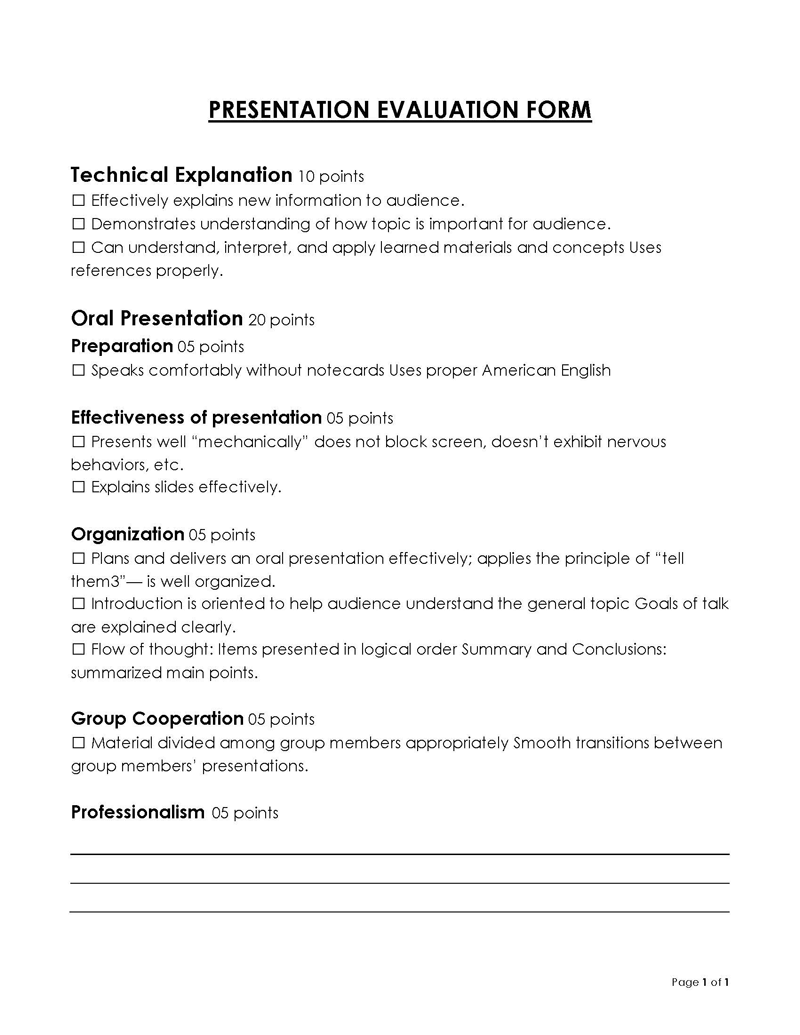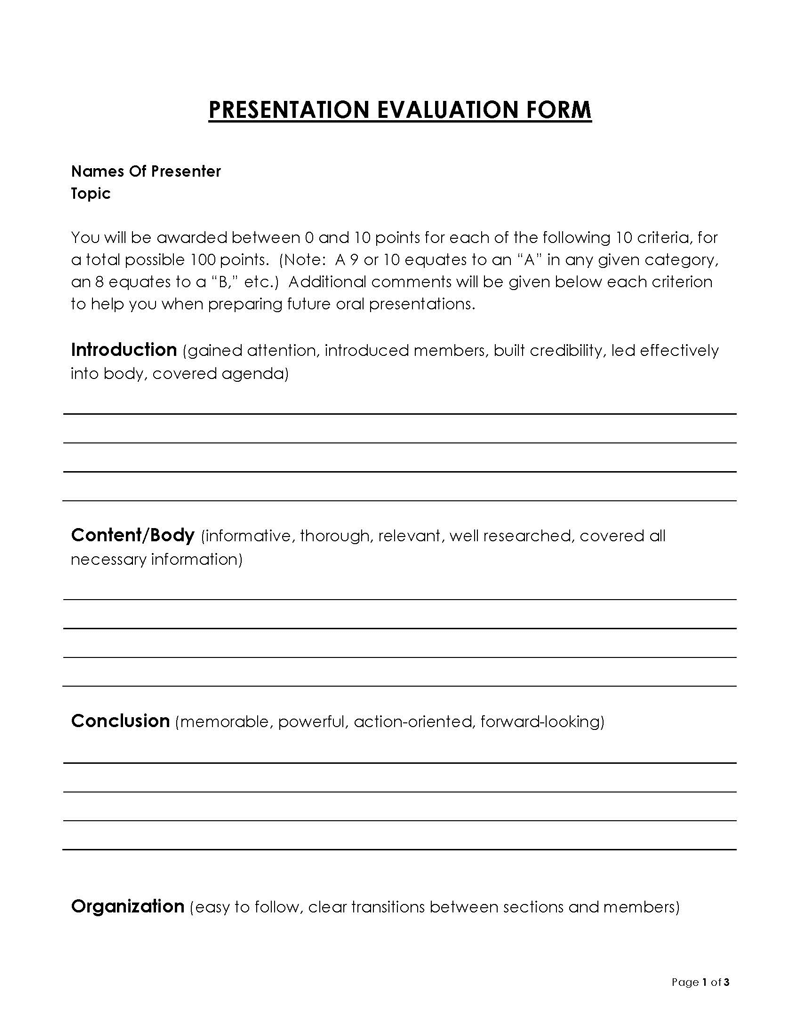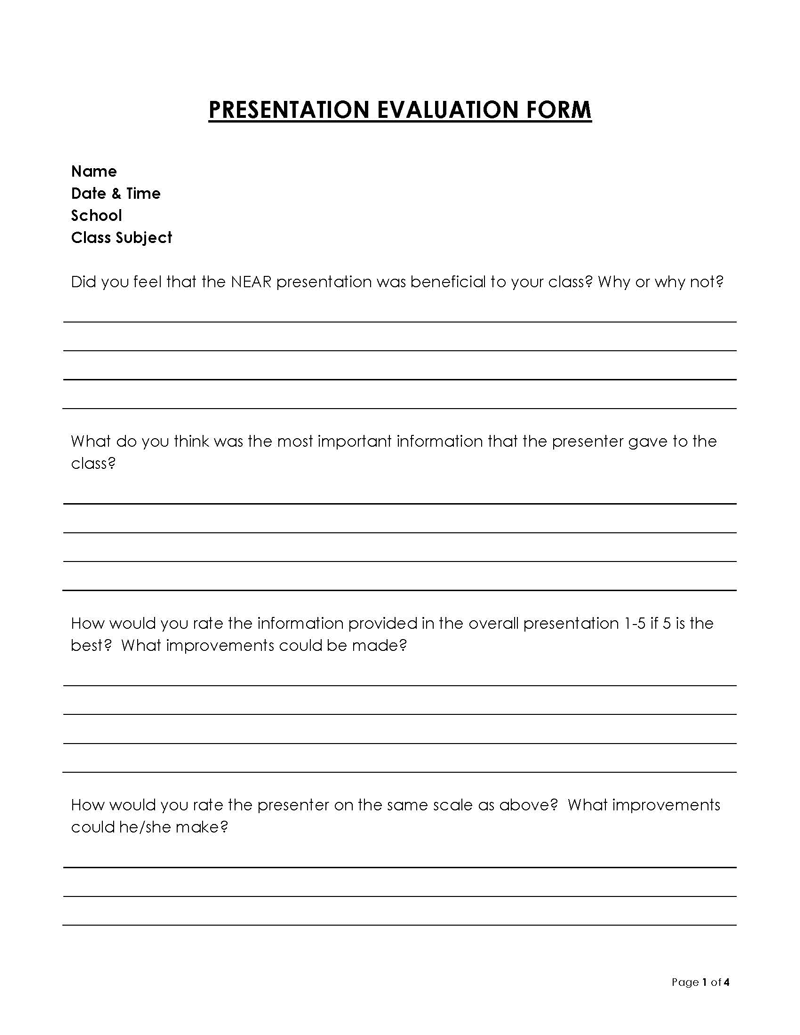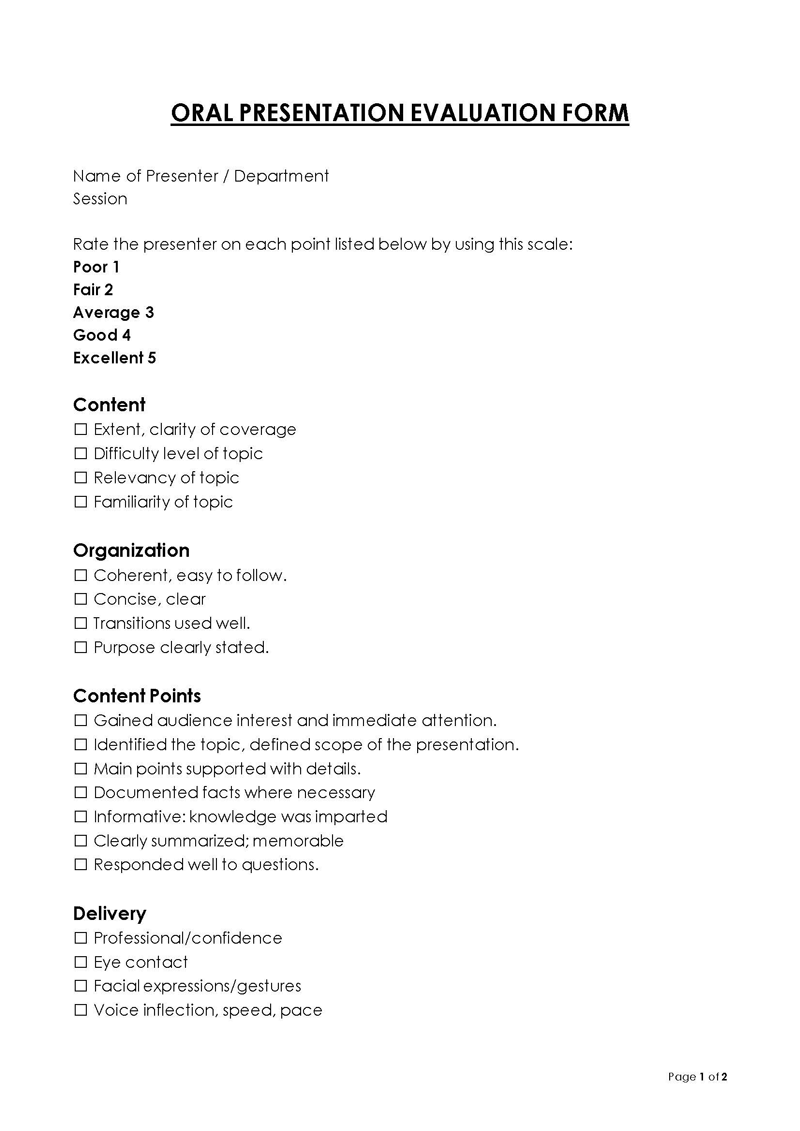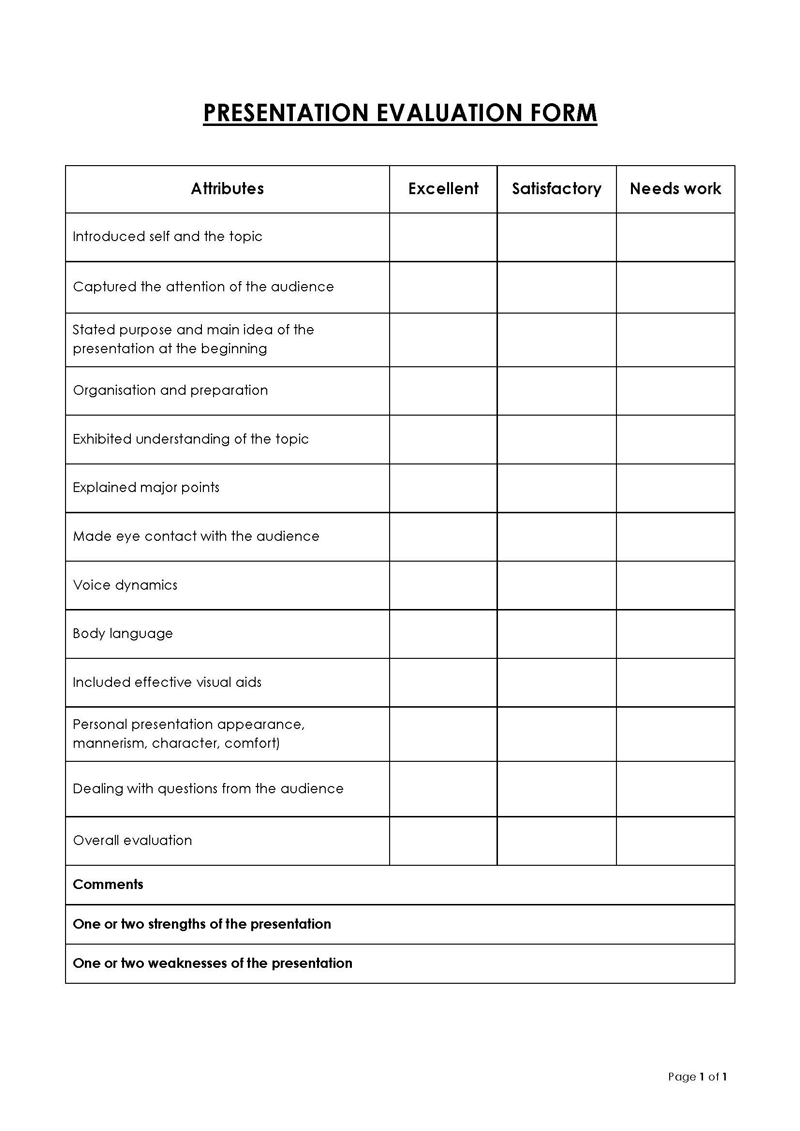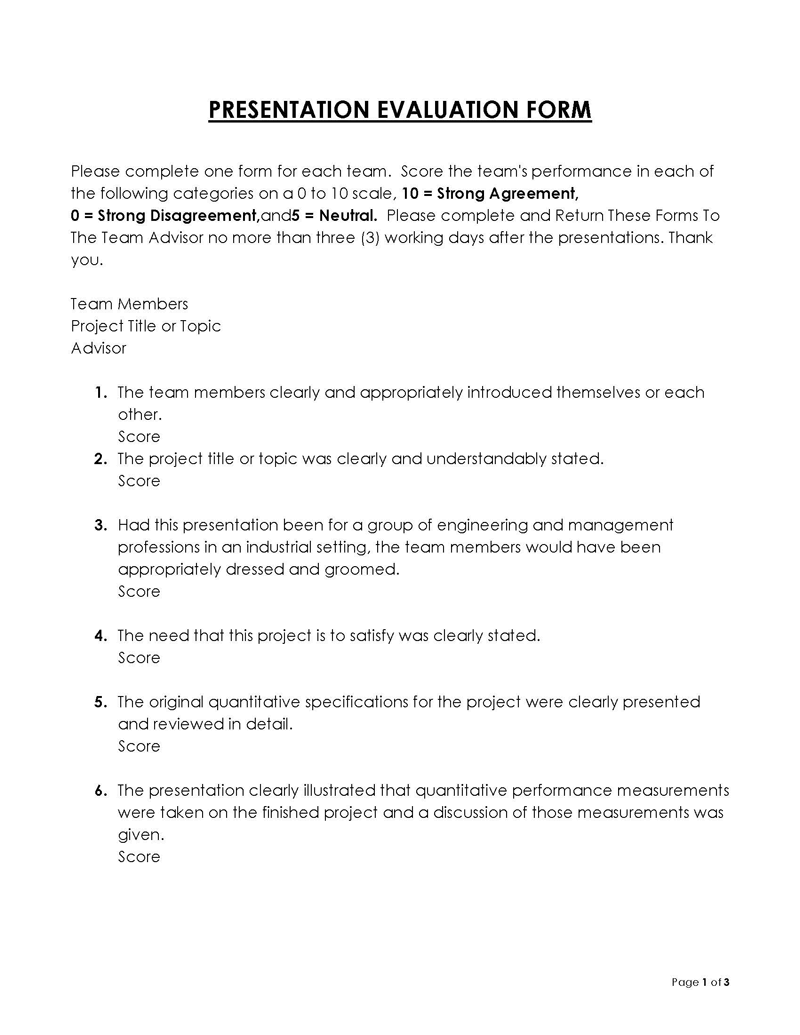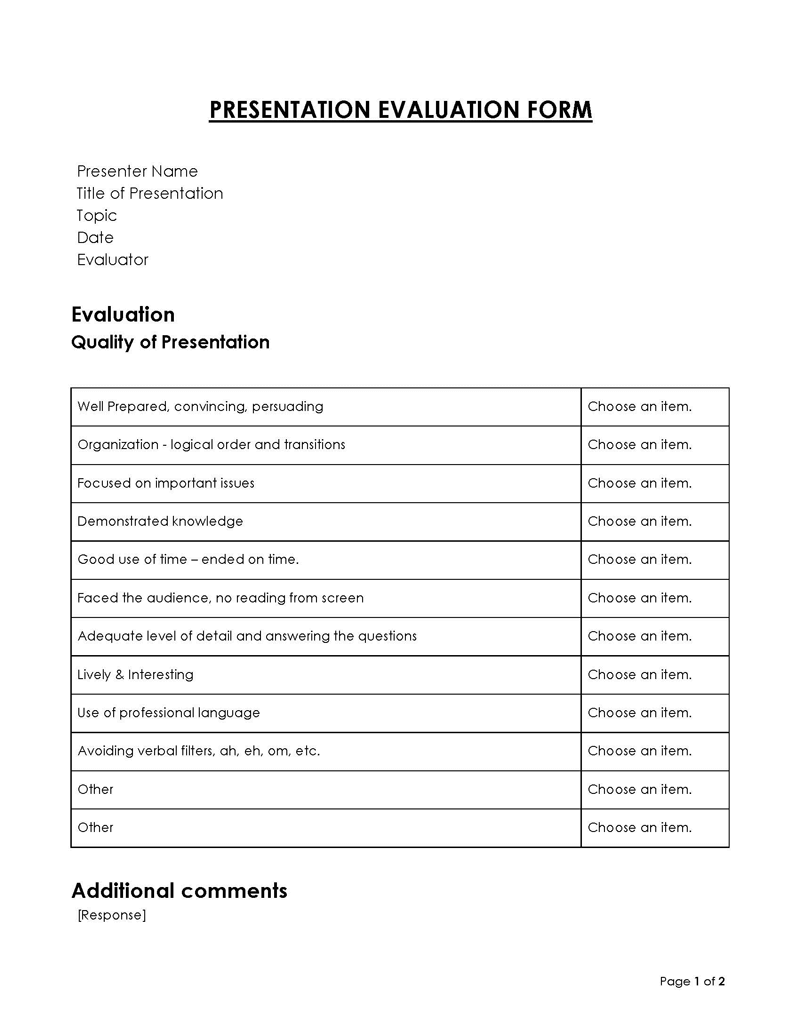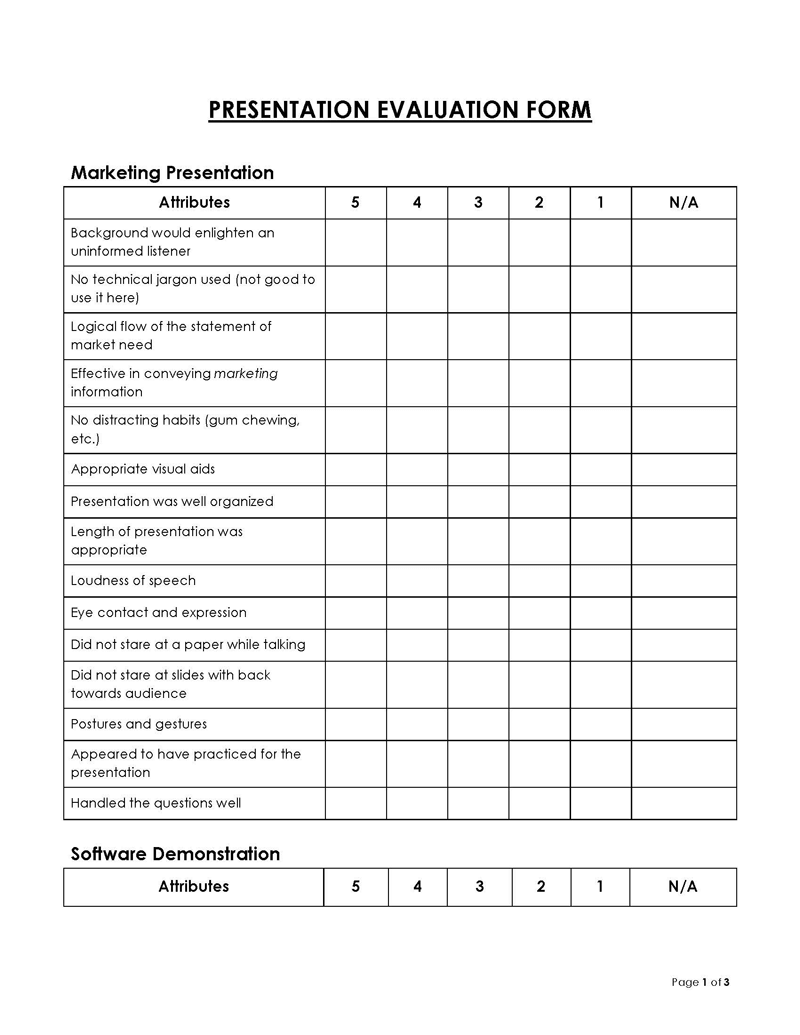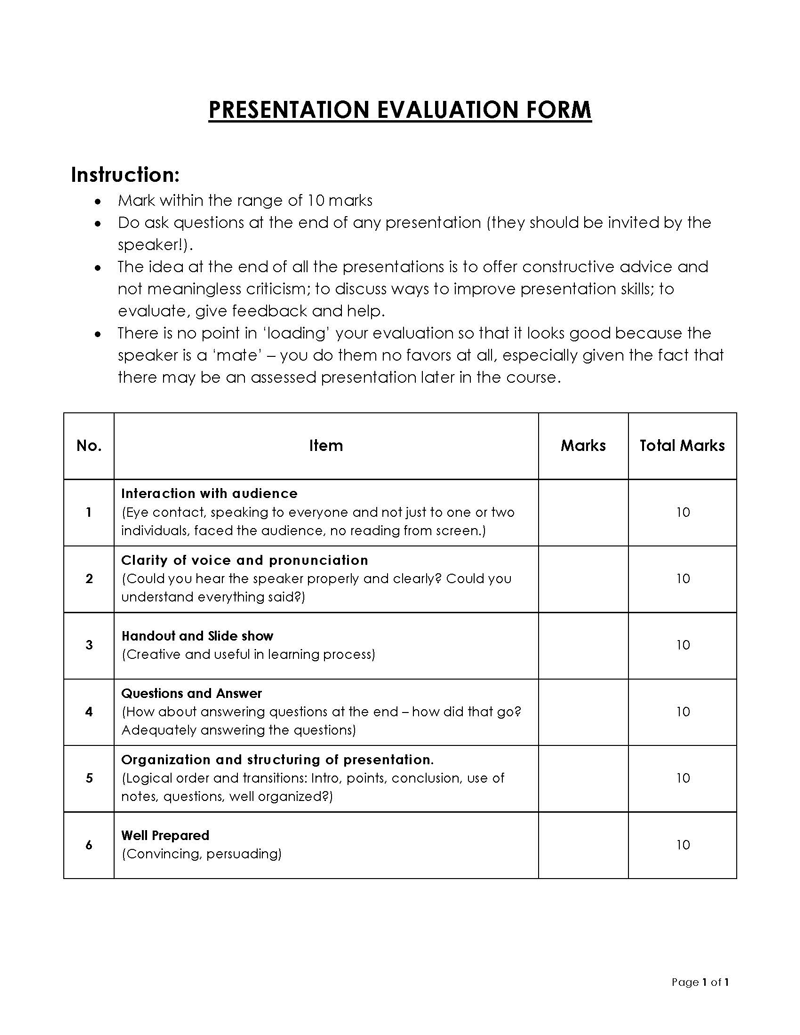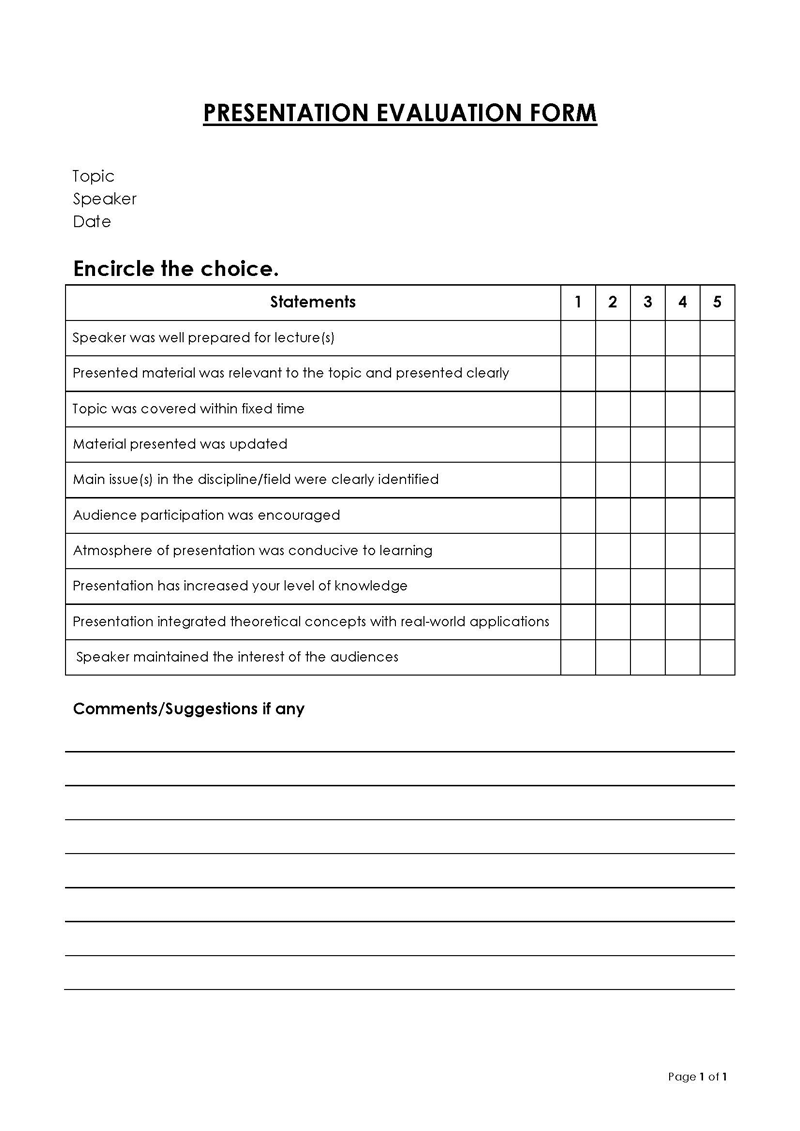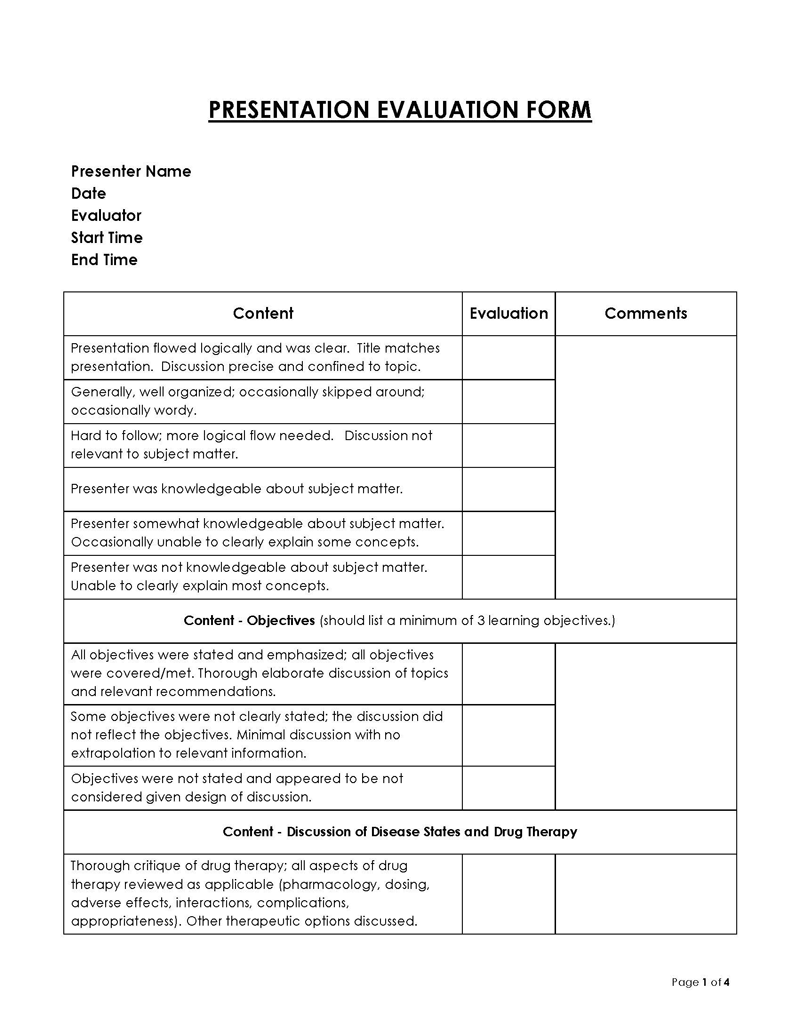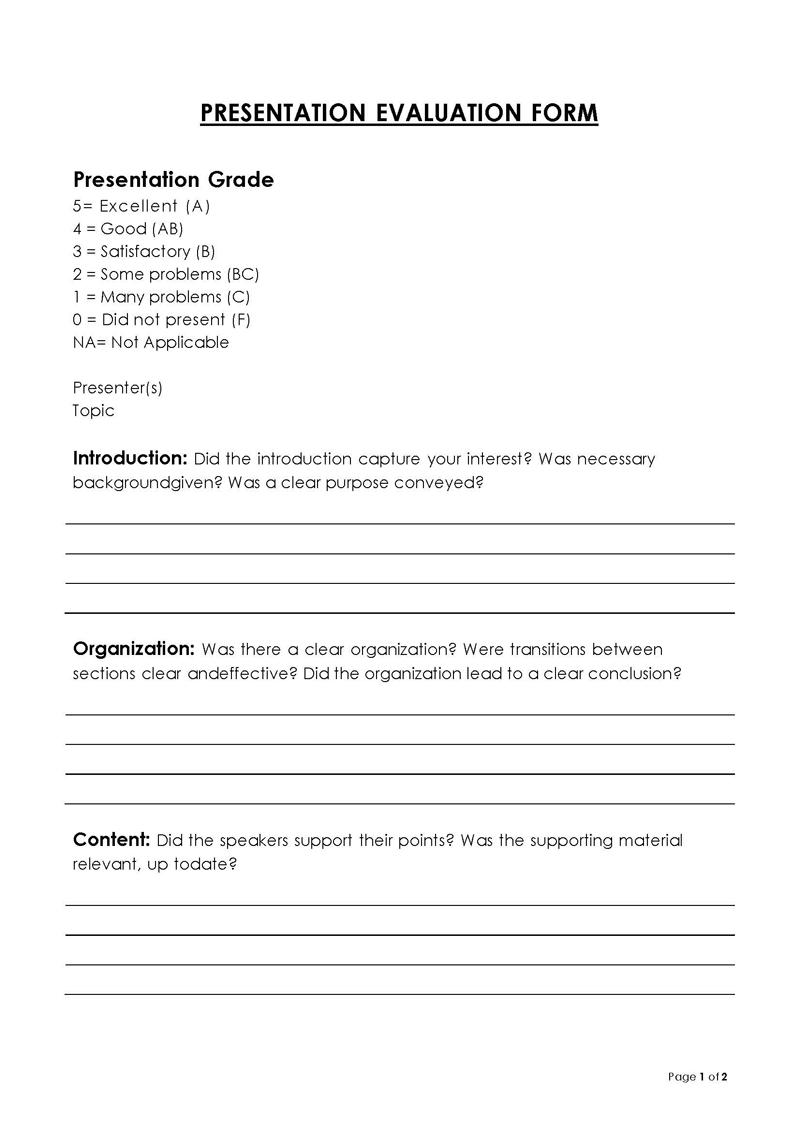A presentation evaluation form is a document used by an evaluator to analyze and review a particular presentation.
The form allows you to give structured feedback to the presenter about their presentation. Additionally, it can be used whenever you want to rate an individual’s presentation skills. Assessments are an important means for individuals to improve themselves, and you must therefore provide the presenter with accurate feedback regarding their presentation. This will enable them to make the necessary adjustments and enhance their presentation skills.
Furthermore, the feedback form allows you to judge whether the presenter comprehensively covered all the important topics and answered questions appropriately. An elaborate presentation should be able to give clear insights into the chosen topics. For example, if the presentation is about the advantages and values of using the company’s products and services, everyone present during the presentation should be able to clearly understand the products and their market valuation.
The form used to evaluate presentations, its purpose, the evaluation criteria, and some helpful assessment advice will all be covered in this article.
Download Free Form Templates
A presentation evaluation form should be comprehensive as it is meant to provide the presenter with honest reviews of their performance. To ensure you have a form that is thorough, you should use a template to prepare it. That will make it easier for you to create a proper form.
Also, it will ensure that you have all the required sections and details. You can access and download these templates for free from below:
Purpose of Presentation Evaluation Form
An evaluation form allows you to give a critical review and evaluation of a presentation. Different aspects of the presentation are judged as part of the evaluation; this includes the presenter’s effectiveness and efficiency in imparting information, body language, enthusiasm, volume, modulation, ease of flow, clarity of speaking, and the presenter’s overall preparedness.
Therefore, after you have reviewed the presentation, you should share your comments with the presenter. They can use it to understand what they need to do to improve their overall performance. Furthermore, your feedback form should be easy to understand and should convince the presenter to take action towards improving their confidence and appearance.
Also, you may give suggestions to help the presenter improve their emotional control during presentations; this is an effective way of convincing and persuading the audience.
A well-drafted review will allow you to give your opinion without sabotaging the presenter’s confidence. Therefore, feedback has to be constructed positively but must also provide clear instructions about those areas that need improvement.
3 Different Kinds of Presentation Evaluations
An effective way of helping individuals give powerful and informative presentations is by informing them on how their presentations will be evaluated.
Here are three techniques you can use to evaluate a presentation:
Self-evaluation
One of the most effective ways of improving someone’s presentation skills is by allowing them to judge their own performance. This can be achieved by making them rate their presentations. Occasionally, there are those who will be able to give accurate and insightful reviews on what they did well and where they need to improve. Also, there are some who will find it difficult to evaluate themselves.
Asking a presenter questions about their performance will enable you as an evaluator to assist them in self-evaluation. You can ask them how they think they performed, what they think they have accomplished, what they gained before, during, and after the performance, and what they think they could have done differently during the process of presenting.
Peer evaluation
Assessment by peers encourages the presenters to provide feedback on each other’s performances. For instance, if you are a teacher, you can ask your students to give their opinions about their classmates’ performances. Peer evaluation is an effective way of helping the students to differentiate between a perfect and an average presentation.
Also, this will allow them to be more attentive as they observe and learn how to present their projects effectively. You can distribute forms to each student to give their feedback. Then, you can request that they give the forms to the presenter at the end of the presentation.
Professional evaluation
Professional evaluations of presentations are usually conducted by someone like a teacher. Therefore, as an evaluator, you are required to verbally give your comments instead of recording them on some evaluation forms. In most cases, you are required to discuss the presentation immediately when it ends; this allows the presenter to get immediate feedback.
To professionally evaluate a presentation, you can ask for its copy prior to the presentation. This will allow you enough time to review the contents and be prepared to give provide a comprehensive assessment. As a result, you will be able to help the presenter get better at their future presentations.
Evaluation Criteria for Presentation
A presentation is judged on six criteria. The individual or group presenting their work must have the required skills to present their content effectively.
Below are the six abilities that you must assess as part of the evaluation:
Ability to analyze the audience
You need to assess if the presenter understands their audience based on the following:
- Whether their content was tailored and relevant or just generic
- If the pitching was done correctly
- If they used proper language
- If they used terminology that the audience understood
- If they engaged their audience
- If their audience seemed focused or distracted.
If the presenter understands the audience, they will most likely have a great presentation. As an evaluator, you must determine if the presenter researched their audience and was able to handle any challenges they encountered during their presentation.
Ability to develop a structured presentation
You need to determine if the presenter has a structured presentation that makes the content persuasive. The message alone cannot be impactful if it lacks a logical flow and structure of ideas. You should judge if the presentation was clear, easy to follow, and had a narrative or story-like flow with a clear beginning and conclusion.
Also, you need to check if the transitions used between sections were smooth, if the presenter used relevant visual aids such as PowerPoint slides or handouts, and finally, if it had a clear call to action section at the end.
A proper and clear structure is important if the presenter wants their message to impact the audience. It should have a clear start, flow smoothly, build momentum, and have a powerful ending without losing the audience’s attention at any point.
Ability to engage the audience
The presenter must also have the ability to engage the audience. If the presenter properly analyzes the audience, they will most likely be able to connect with them. This is a significant factor that distinguishes a great presentation from a poor one. Ascertain if the presenter had content that the audience would find interesting.
Also, you need to check if the presenter’s method of delivery was effective. The presenter should be able to build a rapport with the members of the audience, use proper gestures and body language, and speak clearly and confidently with proper intonation in a conversational tone.
Ability to prepare effective slides
The ability to prepare slides that effectively convey the intended message is an important aspect of a successful presentation. Slides are visual aids meant for the speaker to elaborate on their information and enable their audience to understand the message thoroughly. You need to determine if these slides are easy to read, have detailed information, and have a proper layout and format for easier understanding.
The slides should have a good balance between text, graphics, and images. The slides can be considered effective if they contain text in bullet points as well as impactful graphics that reinforce the presenter’s message.
Ability to be confident and other strengths
It is also important to evaluate if the speaker does not lack confidence when presenting. The presenter should exude confidence, be natural, and be in control while presenting. You need to assess if they were at ease while speaking to their audience, whether they appeared confrontational, whether they seemed anxious or distracted, and whether they were awkward or shy.
Ability to summarize and achieve intended outcomes
The conclusion should also have a clear and achievable call to action and be inspirational. Therefore, you need to ascertain the presenter’s ability to summarize and conclude their presentation in a manner that ensures they have achieved their intended outcomes. You must assess whether their closing statement was well-rounded and included all the main points. A proper closing should leave the audience with a sense of having achieved something.
Best Tips for You
There are tips that you should keep in mind when evaluating a presentation if you wish to have impactful feedback that will benefit the presenter.
Below are the three main tips that you should consider:
Emphasize the process
You need to focus on the process of preparation rather than the product itself. That means that you should evaluate and comment on the process taken, such as gathering information, analyzing the audience, etc. This is more impactful, and it will help the person identify the areas that need improvement so they can make it better next time.
Be specific
Your feedback should include specific directions to help the presenter improve themselves, rather than just giving opinions.
For example:
Instead of writing, “You were not audible or confident enough during your presentation,” you should write, “At some point during the presentation, you were not audible and did not seem confident. This made it hard to hear or understand you. Pay close attention to your pace and audibility the next time. If you are feeling underconfident, use gestures and take your time to pause instead of using filler words such as “um,” “ah,” and “like.”
End on a positive note
Always conclude your assessment on a positive note. The assessment is meant to motivate a person to develop their presentation abilities. Therefore, it is important that besides highlighting the flaws, also include positive feedback to encourage the presenter
Conclusion
Your job as an evaluator is to assist the presenter in improving their skills. An effective way of doing this is by giving them constructive feedback. Your assessment should not only highlight the shortcomings but also be thoughtful and positive. When you use an evaluation form, you can make precise notes about the areas where a presenter needs to improve and the ones where they did well.
The oral presentation can be challenging and time-consuming. However, with a form, you can comprehensively explain what is expected of a presenter during and after their presentation. Notably, it is important to focus on its different aspects, which include the style of presenting and the contents. As an evaluator, you are responsible for objectively assessing the skills and content of the presenter. Therefore, your feedback should be detailed and effective. Ensure that you have an evaluation criteria that will make it easy for you to provide your comments regarding all relevant aspects. You can use templates to create forms that meet all your evaluation requirements effortlessly.
